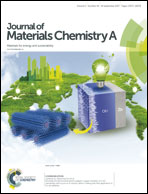Hydrogen evolution reaction catalyzed by ruthenium ion-complexed graphitic carbon nitride nanosheets†
Abstract
The development of cost-effective, high-performance electrocatalysts for hydrogen evolution reaction (HER) is urgently needed. In the present study, a new type of HER catalyst was developed where ruthenium ions were embedded into the molecular skeletons of graphitic carbon nitride (C3N4) nanosheets of 2.0 ± 0.4 nm in thickness by refluxing C3N4 and RuCl3 in water. This took advantage of the strong affinity of ruthenium ions to pyridinic nitrogen of the tri-s-triazine units of C3N4. The formation of C3N4–Ru nanocomposites was confirmed by optical and X-ray photoelectron spectroscopic measurements, which suggested charge transfer from the C3N4 scaffold to the ruthenium centers. Significantly, the hybrid materials were readily dispersible in water and exhibited apparent electrocatalytic activity towards HER in acid and their activity increased with the loading of ruthenium metal centers in the C3N4 matrix. Within the present experimental context, the sample saturated with ruthenium ion complexation at a ruthenium to pyridinic nitrogen atomic ratio of ca. 1 : 2 displayed the best performance, with an overpotential of only 140 mV to achieve the current density of 10 mA cm−2, a low Tafel slope of 57 mV dec−1, and a large exchange current density of 0.072 mA cm−2. The activity was markedly lower when C3N4 was embedded with other metal ions such as Fe3+, Co3+, Ni3+ and Cu2+. This suggests minimal contributions from the C3N4 nanosheets to the HER activity, and the activity was most likely due to the formation of Ru–N moieties where the synergistic interactions between the carbon nitride and ruthenium metal centers facilitated the adsorption of hydrogen. This was strongly supported by results from density functional theory calculations.



 Please wait while we load your content...
Please wait while we load your content...